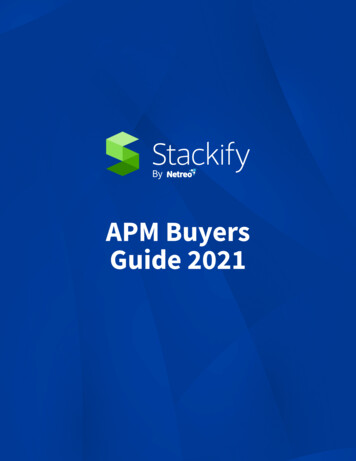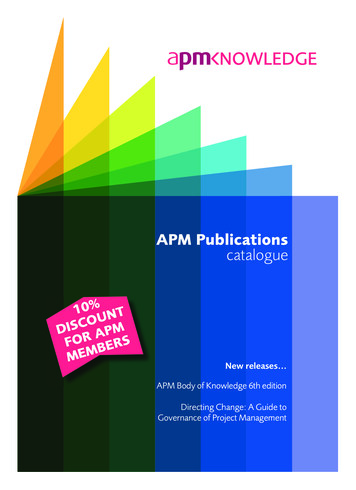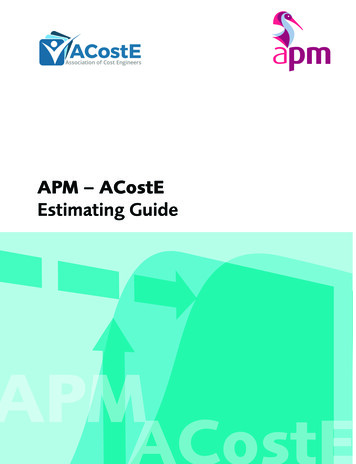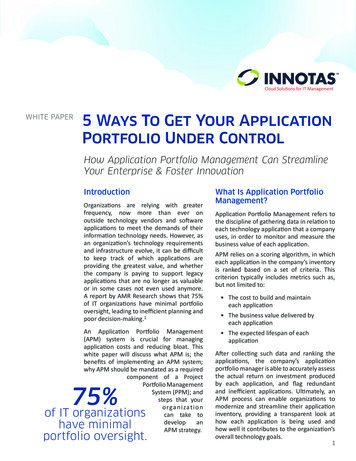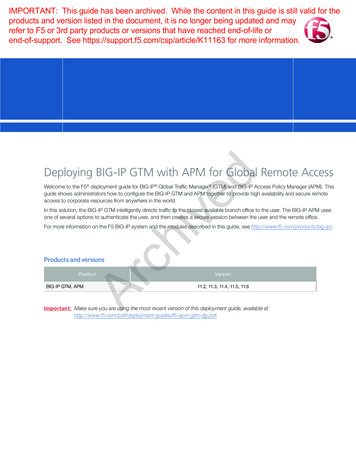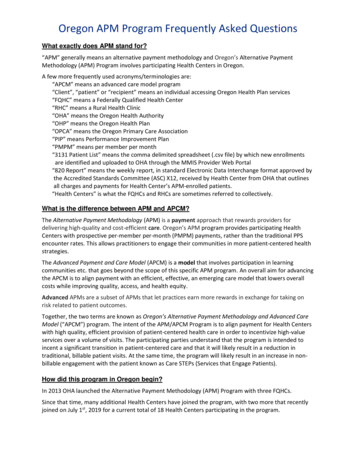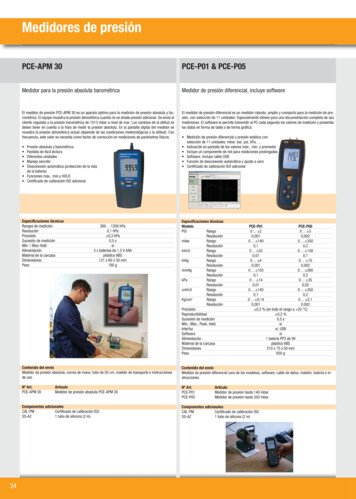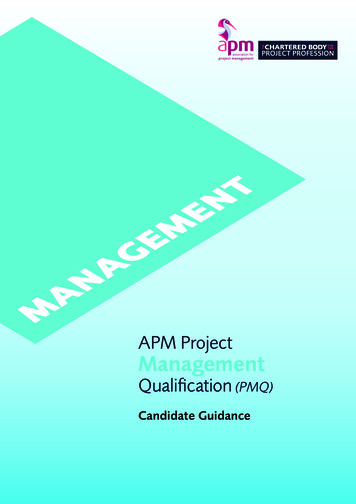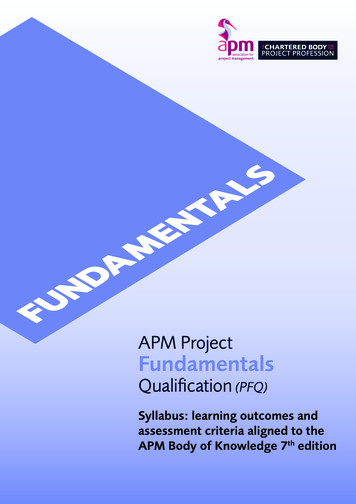
Transcription
APM ProjectFundamentalsQualification (PFQ)Syllabus: learning outcomes andassessment criteria aligned to theAPM Body of Knowledge 7th edition
APM Project Fundamentals QualificationThe syllabus provides a summary of the coverage of the qualification; the details are then found in the learningoutcomes and assessment criteria. Both the syllabus and the learning outcomes and assessment criteria are aligned tothe APM Body of Knowledge 7th edition, but the presentation of the content better reflects teaching approaches thanthe functional breakdown of the APM Body of Knowledge 7th edition structure.Where the syllabus cites the term ‘including’, the information in brackets is topic coverage. All the cited terms within thebrackets and after the term ‘including’ are expected to be known by candidates taking the examination.The examination questions will not require calculations to be performed.Command VerbsBelow candidates can find the definitions of the Command Verbs which are found throughout the syllabus, to help themunderstand the breadth and level of knowledge required of them throughout the syllabus.VerbDefinitionDifferentiateRecognise or determine what makes something different.DefineGive the nature, scope or meaning. This must come fromthe APM Body of Knowledge 7th edition.DescribeGive an account, including all the relevant characteristics,qualities and events.ExplainGive an account of the purpose(s) or reason(s).OutlineSet out the main points/characteristics.StateExpress the details without elaboration.2
APM Project Fundamentals QualificationSyllabus, learning outcomes and assessment criteria aligned to the APM Body of Knowledge 7th editionLearningOutcomeAssessment CriteriaAPM Body of Knowledge 7thedition Reference1. Understandprojectmanagementand theoperatingenvironment1.1 define the term ‘project’Glossary1.2 state the differences between a project and business asusual1.3 define the term ‘project management’1.4 state the key purpose of project management1.5 define the terms ‘programme management’ and‘portfolio management’ and their relationship withproject management1.1.1(Organisational Environment)1.1.5(Structural Choices)1.6 describe why PESTLE analysis might be used by a projectmanager2. Understandproject lifecycles2.1 state the phases of a typical linear project life cycle2.2 state the phases of a typical iterative project life cycle2.3 define the term ‘hybrid life cycle’2.4 define the term ‘extended project life cycle’Glossary1.2.2(Linear Life Cycles)1.2.3(Iterative Life Cycles)1.2.4(Hybrid Life Cycles)1.2.5(Extended Life Cycles)3. Understand3.1 outline project management roles and responsibilitiesthe roles and(including the project sponsor, project manager, projectresponsibilitiesgovernance, project team members, end users, productwithin projectsowner and the project management office)1.3.5(Sponsorship)1.3.8(Temporary Structures)1.3.10(Governance Boards)2.2.1(The PMO)3.3.1(Communication)3
APM Project Fundamentals Qualification4. Understandprojectmanagementplanning4.1 define the term ‘deployment baseline’4.2 state how deployment baselines differ between linearand iterative life cycles4.3 outline the stakeholders of a project management plan4.4 outline the purpose and typical content of a businesscase1.2.2(Linear Life Cycles)1.2.3(Iterative Life Cycles)1.3.5(Sponsorship)4.5 explain the role of a project sponsor and project managerin relation to developing a business case1.3.7(Business Case)4.6 explain how a stakeholder analysis supports effectivestakeholder engagement2.34.7 define the term ‘benefits management’(Transition into Use)4.8 state typical estimating methods (including analytical,analogous, parametric)2.3.1(Business Readiness)4.9 outline the purpose of the estimating funnel4.10 explain why establishing success criteria is important atthe start, during, and at the handover of a project4.11 outline the purpose and benefits of project progressreporting2.3.2(Transition of Project Outputs)2.3.3(Adoption and Benefits Realisation)3.1(Engaging Stakeholders)3.1.1(Stakeholders)3.1.2(Social Context)4.(Planning and ManagingDeployment)4.1.1(Success and Benefits)4.2(Integrated Planning)4.2.4(Estimation)4.2.10(Deployment Baseline)4.3(Controlling Deployment)4.3.1(Progress Monitoring andReporting)4
APM Project Fundamentals QualificationSyllabus, learning outcomes and assessment criteria aligned to the APM Body of Knowledge 7th edition5. Understandproject scopemanagement5.1 define the term ‘scope management’5.2 differentiate between scope management within linearprojects and scope management within iterative projects5.3 describe how product breakdown structures (PBS) andwork breakdown structures (WBS) are used to illustratethe required scope of work5.4 outline how a project manager would use costbreakdown structures (CBS), organisational breakdownstructures (OBS) and the responsibility assignmentmatrix (RAM)5.5 define the terms ‘configuration management’ and‘change control’ in the context of scope management5.6 explain the relationship between change control andconfiguration management5.7 outline the stages in a typical change control process5.8 outline the activities in a typical configurationmanagement process (including planning, identification,control, status accounting and verification audit)6. Understandresource,scheduling andoptimisation ina project6.1 state the purpose of scheduling6.2 state the purpose of critical path analysis6.3 state the purpose of milestones6.4 define the term ‘time boxing’6.5 outline options for resource optimisation (includingresource levelling and resource smoothing)6.6 define the term ‘procurement strategy’Glossary1.2.2(Linear Life Cycles)1.2.3(Iterative Life Cycles)1.3.1(Governance Principles)4.1.4(Scope Definition)4.3.6(Change Control)4.3.7(Configuration Management)Glossary1.2.2(Linear Life Cycles)2.1.4(Procurement Strategy)4.2.5(Scheduling – Critical Path)4.2.6(Scheduling – Critical Chain)4.2.7(Resource Optimisation)7. Understandproject riskand issuemanagement inthe context of aproject7.1 define the term ‘risk’7.2 explain the purpose of risk management7.3 outline the stages of a typical risk management process(including identification, analysis, response and closure)7.4 describe the use of risk registers7.5 define the term ‘issue’7.6 outline the purpose of ‘issue management’7.7 differentiate between an issue and a risk7.8 state the stages of an issue resolution processGlossary4.2.2(Risk Identification)4.2.3(Risk Analysis)4.3.3(Risk Management)4.3.5(Issue Management)5
APM Project Fundamentals Qualification8. Understandquality in thecontext of aproject8.1 define the term ‘quality’8.2 outline the purpose of ‘quality management’8.3 define the term ‘quality planning’8.4 define the term ‘quality control’8.5 outline the purpose of ‘quality assurance’8.6 state the purpose of: decision gates, post projectreviews, benefit reviews and project auditsGlossary2.2.2(Decision Gates)2.2.4(Audits and Assurance)2.3.5Administrative Closure ofProducts)3.3.4(Regulatory Environment)4.1.5(Quality Planning)4.3.8(Quality Control)9. Understand9.1 define the term ‘communication’communication 9.2 outline the advantages of different communicationin the contextmethods (including face to face, physical and virtual)of a project9.3 outline the disadvantages of different communicationmethods (including face to face, physical and virtual)Glossary3.3.1(Communication)9.4 outline the contents of a communication plan9.5 explain the benefits, to a project manager, of acommunication plan10. Understand10.1 define the term ‘leadership’leadership10.2 explain how a project team leader can influence teamand teamworkperformancewithin a10.3 outline the challenges to a project manager whenprojectdeveloping and leading a project team10.4 outline how a project manager can use models to assistteam development (including Belbin and .3(Team Development)3.2.4(Leadership)6
APM Project Fundamentals QualificationSyllabus, learning outcomes and assessment criteria aligned to the APM Body of Knowledge 7th editionNotes7
Association for Project ManagementIbis House, Regent ParkSummerleys RoadPrinces RisboroughBuckinghamshire HP27 9LETel (UK)Tel (Int)EmailWeb0845 458 1944 44 1844 271 640info@apm.org.ukapm.org.ukAssociation for Project Management is incorporated by Royal Charter RC000890and a registered charity No. 1171112. Principal office as shown. Association for Project Management 2019 V4
1.4 state the key purpose of project management 1.5 define the terms 'programme management' and 'portfolio management' and their relationship with project management 1.6 describe why PESTLE analysis might be used by a project manager 2. Understand project life cycles 2.1 state the phases of a typical linear project life cycle Glossary
